Buchmann Galerie - 30 Years
Group show
28 MAR until 26 APR 2025
Opening – 28 MAR 2025, 6-8 pm
On April 1, 2025, Buchmann Galerie celebrates its 30th anniversary.
Founded in Cologne in 1995, the gallery has been located in Berlin with two adjacent exhibition spaces since 2005.
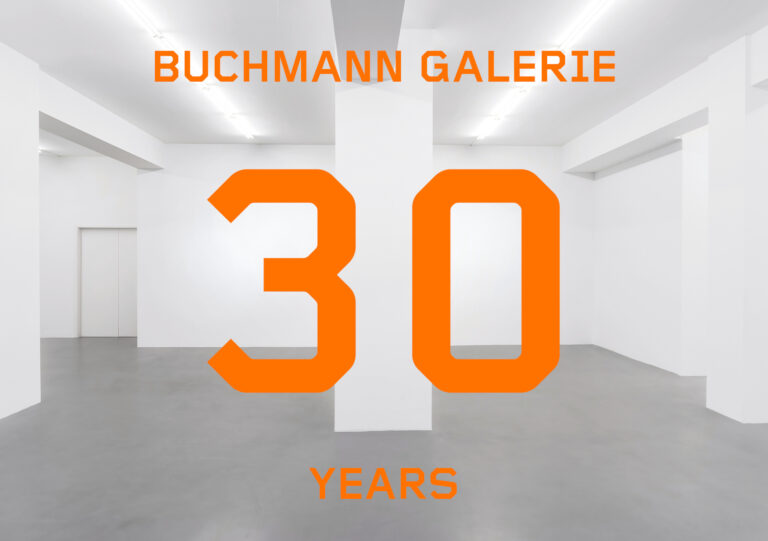
Buchmann Galerie – 30 Years
Photo Michael Schultze
Representing a roster of acclaimed established artists with a focus on painting, sculpture, drawing and photography creates the context for the gallery program. Works by the gallery artists are featured in prestigious collections worldwide, such as the MoMA New York, the Centre Pompidou Paris, the Tate London, the Neue Nationalgalerie Berlin, the Istanbul Modern Museum or the M+ Hong Kong. Many of the artists have been represented by the gallery from an early stage in their careers.
Several of the gallery’s artists have been recognized with prestigious international art prizes; such as, the Turner Prize and the Praemium Imperiale, which has been awarded to three of the gallery’s artists.
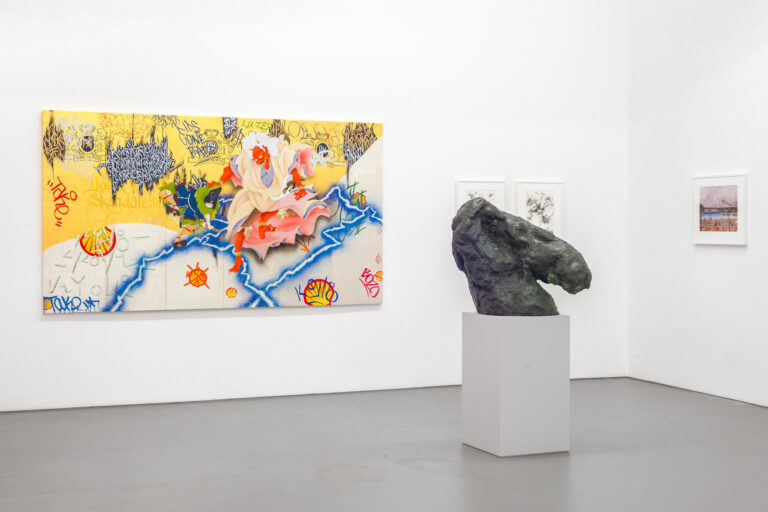
Buchmann Galerie 30 Years, 2025
Installation view
Photo: Michael Schultze
Working closely with museums and public institutions, the gallery has placed works with, for example, the M+ in Hong Kong, the Art Gallery of New South Wales in Sydney, the Nasher Sculpture Center Dallas, the Centre Pompidou Paris, or the Pinakothek der Moderne Munich.
The exhibition “Buchmann Galerie — 30 Years” shows selected works by all the artists with whom the gallery has worked closely in recent years.
Exhibiting artists:
Anna & Bernhard Blume, Greg Bogin, Daniel Buren, Pedro Cabrita Reis, Lawrence Carroll, Tony Cragg, Martin Disler, Gajin Fujita, Alberto Garutti, Des Hughes, Raffi Kalenderian, Wolfgang Laib, Jason Martin, Tatsuo Miyajima, Wilhelm Mundt, Arnold Odermatt, Bettina Pousttchi, Fiona Rae, Joel Sternfeld, William Tucker, Lawrence Weiner and Clare Woods.
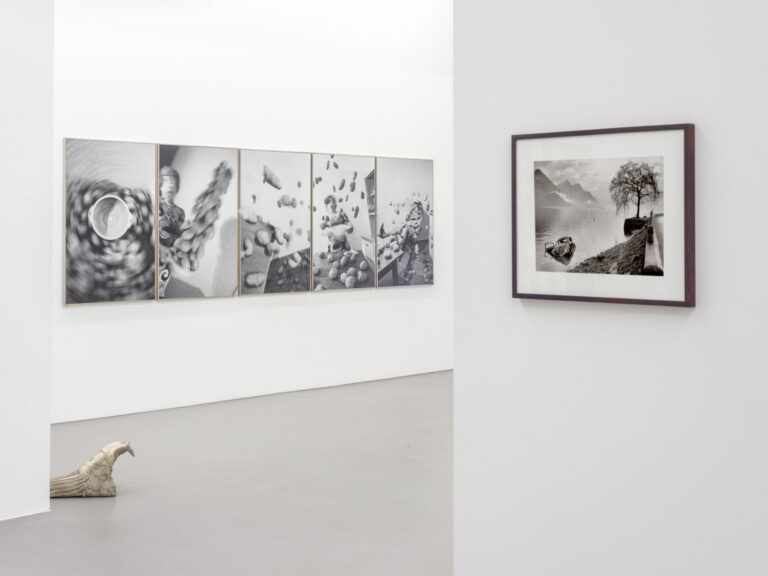
Buchmann Galerie 30 Years, 2025
Installation view
Photo: Michael Schultze
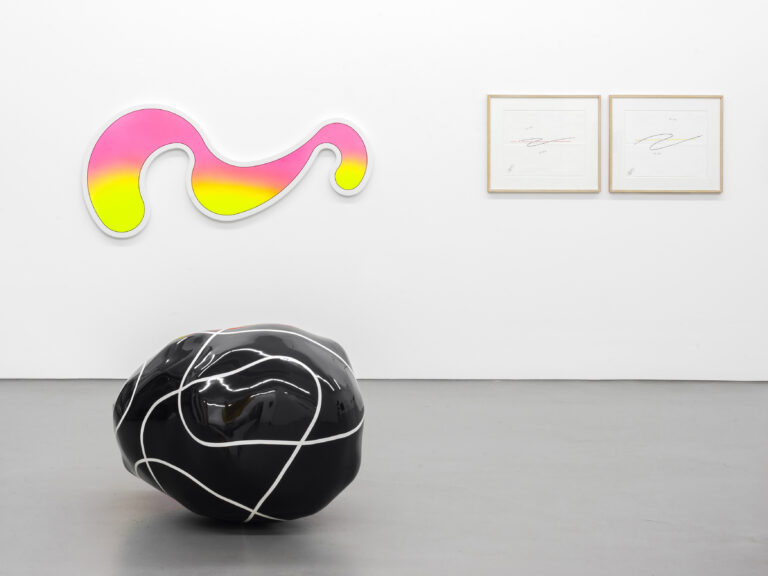
Buchmann Galerie 30 Years, 2025
Installation view
Photo: Michael Schultze
The works in the exhibition „Buchmann – 30 Years“ are a personal selection. They follow neither a chronological nor a thematic order. These are works that are particularly related to the history of the gallery and the collaboration with the artists.
1) Anna & Bernhard Blume
„Küchenkoller“ (Kitchen Frenzy) belongs to the same-named series and is probably the most famous work of the incomparable artist duo. There are different versions and formats of these iconic pieces. The five-part work on display here is one of the larger versions. A slightly larger version is part of the collection of the Museum of Modern Art in New York. The Kunsthalle Krems recently presented Anna & Bernhard Blume in a major solo exhibition.
2-3) Clare Woods
The artist became known for her large-scale landscape paintings, some as large as 3×10 meters, to which the two smaller paintings in the exhibition provide a deliberate contrast. They also show how the artist has recently turned to a new form of genre painting with various series, including still lifes and interiors. „Soft Peak“ humorously oscillates between a still life—a traditional English Trifle—and a landscape, while „New Problems 8“ blends between an abstract painting and a depiction of a crocheted tablecloth, which may reference Blume‘s lower-middle-class kitchen as well as Des Hughes’ small floor sculpture.
4) Des Hughes
As with Blume, moments of idiosyncrasy and eccentricity characterize the work of British artist Des Hughes, who combines text and signs in his embroidered works into humorously profound pieces. Subversive and light-hearted, his small floor sculpture „Waiting for the Miracle“ features a surface texture reminiscent of a medieval chainmail or thick knitted sock. Des Hughes creates a narrative and ironic figuration in a distinct, recognizable visual language.
5) Pedro Cabrita Reis
Found materials are often the starting point for the objects and sculptures by Pedro Cabrita Reis. He takes them from the social and utilitarian context and reconfigures them artistically and poetically, giving them new sensuality. In „Distant Landscape,“ physical and emotional spaces merge, where the open window offers a view onto an imaginary green painted landscape, yet the real view behind the window is obstructed.
6) Daniel Buren
Like few others, Daniel Buren has the ability to completely alter the impact and perception of spaces with his minimal interventions, based on his legendary white stripes, each 8.7 cm wide. The corner piece made of mirrors, which has white stripes only on one side, transforms the entire space into a crystalline structure. The work was first exhibited in 2005 in Daniel Buren‘s inaugural exhibition at the Berlin gallery space at Charlottenstrasse 13.
7) Arnold Odermatt
The photographs of police officer and photographer Arnold Odermatt have a distinctive signature, marked by their tidiness, sobriety, and sometimes their melancholy or situational humour, making them highly authentic. Taken with a Rolleiflex camera from the mid-1950s to the late 1970s, his quirky shots of traffic accidents and collisions gained international attention after 2001 when Harald Szeemann invited the photographer to the Venice Biennale. „Buochs“ from 1965 is one of the artist’s most famous works, shown in all major exhibitions, including at the Art Institute of Chicago.
8-11) Wolfgang Laib
When Wolfgang Laib represented Germany at the Venice Biennale in 1982, he included in the catalogue a sequence of around 30 black-and-white photos of bushes, trees, and meadows, where he continues to collect pollen in his cycle of nature. These same meadows were also where he collected pollen for his large installation at the Museum of Modern Art in New York in 2013. The photos in the exhibition are the ones used as references for the Biennale catalogue and have never been shown before. Kunsthaus Zürich will present a major solo exhibition of Wolfgang Laib this fall.
12) Jason Martin:
Jason Martin has become known for his monochromatic paintings, which have a finely ribbed surface. The silky gloss of the oil paint, brushed in thin layers and gentle waves on an aluminium base, traces the gesture of the painter and creates the impression of movement, reminiscent of folds, landscapes, or geological formations. The fascinating optical effect, like a curtain or veil, sits between the viewer and the highly tense tactility of the painting‘s surface. The light models the brushstroke, almost making it appear sculptural. For Jason Martin, painting is also a performative act.
13) Lawrence Carroll
Lawrence Carroll’s nuanced artistic work operates at the boundary between painting and sculpture. The artist created a diverse and coherent body of work, marked by a unique poetic presence. Simple materials are subjected to a long, intense process of refinement and reflection. Time plays a key role in this work. Many paintings and objects were created over long periods of time, in sometimes different locations. The object-like quality of his works encouraged the artist to give attention to the meaning of the works in space and to the space itself. Carroll investigates scale and space, the relationship between light and shadow, object and colour. „The inspiration for colour can come from anywhere: from dust, from the shadows of fading light, from a bruised leg, from a sun-bleached mountainside, from the sky of the black night reflected on a lake, from the awakening of a day,“ says the artist.
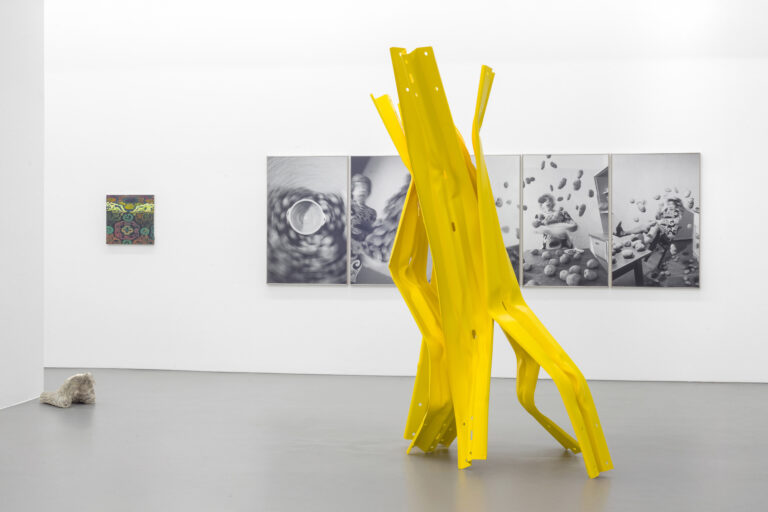
Buchmann Galerie 30 Years, 2025
Installation view
Photo: Michael Schultze
14) Joel Sternfeld
Equipped with a large-format camera and colour film, Joel Sternfeld travelled across the USA several times in a camper van from the late 1970s to around the mid-1980s. The iconic group of works ‘American Prospects’ was created on these countless journeys. It traces the American Dream in its contradictions and its disintegration. They are haunting images of a utopia slipping away. ‘Wet‘n Wild Aquatic Theme Park, Orlando, Florida, September 1980’ in the exhibition is considered a key work in this group of works. Prints of this work are in the collections of the Whitney Museum of American Art New York and the Birmingham Museum of Art. A version as a C-print is held in the collections of MoMA New York and SFMOMA San Francisco.
15-16) Fiona Rae
Over the last thirty years Fiona Rae has produced a distinctive body of work rooted in a conceptual examination of the problems and possibilities of abstract painting. The major part of her painterly work makes extensive use of colour. In her drawings Fiona Rae has set aside her broad colour palette to focus exclusively on black charcoal. Drawing with charcoal seems almost like a liberation, opening up the potential to give the issue of form and background, space, areas and lines a new level of concentrated dynamism. Fiona Rae’s signature is clearly legible in these works. In a very loose form, they show the visual codes that she has developed in her painting oeuvre over the past years using fragments culled from the internet, from films, from advertising and pop culture.
17) Gajin Fujita
The painterly work of Gajin Fujita is characterised by its bold mixture of classical Japanese motifs and painting techniques, the dynamic aesthetic of graffiti, and diverse references to Western and East Asian art history. The artist skilfully weaves codes from American pop culture with visual elements from Japanese culture, which Fujita knows through his heritage, though as an American-born artist, he experiences it from a distance. From this experience of double foreignness, the artist creates his precise and powerful work. The tension between tradition and contemporary culture is also emphasized by the use of gold leaf as the painting‘s ground, which historically has been used for precious works, from the Orient to the West. For Fujita, it serves as the base for graffiti tags and glowing lacquer colours. Christopher Knight of the Los Angeles Times praised Fujita’s painting as „the most important interpretation of the influence of graffiti on art in the 21st century.“
18) Tatsuo Miyajima
Tatsuo Miyajima’s work, which lies at the intersection of technology, digitality, and art, deals with existential questions about the nature and perception of time and space. With his multifaceted work, he is considered one of the most relevant Japanese artists of today, often exhibited alongside Lee Ufan or On Kawara. Three guiding concepts define his work: „Keep Changing,“ „Connect with Everything,“ and „Continue Forever.“ These form the thematic foundation for both monumental LED installations and his drawing and painting oeuvre. Numbers and sequences of numbers serve as a visual representation of these topics in his works, as can be seen in the piece „Counter Painting on KIMONO OBI – Red“ which is shown here. They metaphorically represent life and impermanence, symbolized by the number „0,“ which, however, never appears as a number but rather as a visual—here, a painterly—absence or gap.
19) Wilhelm Mundt
The most well-known sculpture group by Wilhelm Mundt is the „Trashstones,“ whose biomorphic forms are always determined by their content. The interior of the sculptures consists of studio waste, which the artist covers with coloured polyester, aluminium, or bronze. The final form of the „Trashstones“ only hints at the contents inside. There is a discrepancy between what is visible, the shiny, colour-shimmering, and softly modulated exterior, and the interior of the sculpture. A white line on the black surface of „Trashstone 766“ explores a further dimension: the interplay between drawing and sculpture. The soft form of the object is outlined by a line embedded into the surface. Like a thread, the line wraps around the stone, seemingly without a beginning or end, without direction.
20-21) Lawrence Weiner
Lawrence Weiner suggests a particular direction in his two drawings. Once it is a landscape with a horizon line, and then it could be a physical observation or an experiment with vector arrows. In any case, it is about everything, as the title indicates. A master of reduction and working with language, Lawrence Weiner is famously a founder of Conceptual Art and has fundamentally changed the concept of sculpture through the use of language.
22) Greg Bogin
Greg Bogin’s current paintings are large-scale, colourful, intensely glowing, and sometimes even confusing. His paintings seem to float through the ether. But although they seem to be inspired by light, rays and air, they also read like sculptures that outline, cut through and delimit space. The eye follows the intensities of colour, the subtle shifts in gradients, while the surfaces evoke memories of surfboards or custom cars from the Southern Californian pop movement. The works, created with meticulous handcraft on canvas, feature small flaws on the surface, which initially appear flawless. These flaws are fully accepted and remind us of the humanity behind the object. The shapes, which suggest weightlessness and transience, are in fact determined. A blend of abstract painting, minimalism, and pop art influences Bogin. He sees himself as an abstract painter, but his works resist conventional labels. „One of the things that draws me to abstraction is the ability to communicate multiple ideas without being literal or specific, and in this sense, I remain an ‘Abstractionist,’ but I don’t follow any dogma and work on instinct,“ says Bogin. The painting „Good morning“ is a wonderful current example of the New York painter‘s work. The object-like appearance of the painting, with its smooth, reflective surface and rounded form, is in dialogue with Wilhelm Mundt‘s fiberglass sculpture.
23) Alberto Garutti
The Italian curator Francesco Bonami has stated about Alberto Garutti: „Distance, between places and people, is not for Garutti a void that must be filled, but an invisible road that connects us, as long as we have the desire and curiosity to walk along it.“ The work in this exhibition connects two places of personal significance for the artist: Berlin and the Villa Tugendhat by Mies van der Rohe in Brno, Czech Republic. The distance between these two places is 549 km, visualized by the thin pink nylon thread wound onto a spool. The thread can also be understood as a dialogue, a conversation thread or a red thread. The reflection on places and distances is also a theme found in Bettina Pousttchi’s sculpture „Vertical Highways.“
Sculptures 24) Bettina Pousttchi
In recent years, Bettina Pousttchi has incorporated objects into her sculptures that structure the physical experience of urban space. The artist created the sculpture „Vertical Highways A32“ from guardrails. By bending or pressing and using clear, bright colours, Bettina Pousttchi frees everyday objects from their regulatory function. She releases them from their original meaning, transforming them into symbols of change, fluid structures, and dissolving boundaries. With her serial approach to the material, the artist conceptually connects to Minimal Art and the Readymades of Marcel Duchamp. A striking six-meter-high red sculpture from this series, „Vertical Highways,“ has been permanently installed in front of Berlin‘s main train station since spring 2023. Another monumental sculpture is on view in the large foyer of the newly opened Museum Reinhard Ernst in Wiesbaden. „Vertical Highways A32“ was shown last year in a major Bettina Pousttchi exhibition at the Museum Haus Konstruktiv in Zurich.
25) Tony Cragg
The large, over two-meter-tall, red lacquered wood sculpture „Red Figure“ exemplifies Tony Cragg’s unique visual language, which has given new forms of expression to sculpture. Beyond representation, Tony Cragg connects the figurative with the abstract and imbues the sculpture with a sense of movement. Its ascending, biomorphic zigzag form seems to progress in a way that recalls the Italian Futurist Umberto Boccioni‘s „Unique Forms of Continuity in Space.“ Yet, it resists concrete grasp. As Tony Cragg says, „We are beyond the stage where we can simply represent things as sculpture. We must find new means of expression, a new visual language.“ One of the first versions of „Red Figure“ was displayed in 2011 alongside masterpieces of 17th and 18th-century sculpture at the Louvre in Paris. The sculpture in this exhibition was prominently featured in a major Tony Cragg show at Castle Howard in England last year.
26) William Tucker
Following his initial foray into geometric abstract sculpture, William Tucker subsequently created a series of sculptural works from the mid-1980s onwards that developed the figure out of abstraction. His work focuses on the artistic intervention needed in a material to make a figure recognizable. The resulting sculptures address questions of volume, balance, proportion, and surface texture. In addition to series of torsos, heads, and portraits, there is a group of a dozen works that explore the depiction of horses. Tucker deliberately refers to the significance of animal sculpture and representation in cultural history—think of the Trojan horse, the horses in the west frieze of the Parthenon, or the horses of San Marco in Venice and the terracotta horses in Chinese culture.
Office:
27) Raffi Kalenderian
Raffi Kalenderian is a painter of modern life in the sense defined by Charles Baudelaire in his seminal essay of the same name. He employs painterly means to explore the possibility of illustrating contemporaneity in portrait form. In his essay Baudelaire makes a passionate case for a new, entirely nonacademic understanding of beauty in the depiction of people. Following a rich tradition of portrait art from Matisse to Hockney, Kalenderian succeeds in defining the figures‘ psychology through the surrounding space, so establishing a universal quality yet lending a complex visualization to the portrait subject. The exhibition features a self-portrait entitled Self Portrait (Purple Haze) from 2007, which displays all of the Californian painter‘s iconographic elements: the emphasis on the interior, flat perspectives and ornamental structures with often almost psychedelic backgrounds.
28) Martin Disler
The Buchmann Gallery has been representing the estate of Martin Disler since 2013. Martin Disler, born in Seewen, Switzerland in 1949, was a self-taught painter, sculptor and writer. He lived the life of a restless traveller, moving between New York, Zurich, Amsterdam, Lugano, Samedan and Milan, before finally settling in Les Planchettes in the Swiss Jura Mountains. Martin Disler died on 27 August 1996 at the early age of 47. Disler first attracted international attention with his exhibition Invasion durch eine falsche Sprache at the Kunsthalle Basel in 1980. In the years that followed, he rapidly gained recognition with solo exhibitions in major institutions and by participating in the Venice Biennale in 1980 and documenta 7 in Kassel in 1982. The drawing in the exhibition dates from 1988 and is a testament to the pictorial energy of this exceptional artist.
